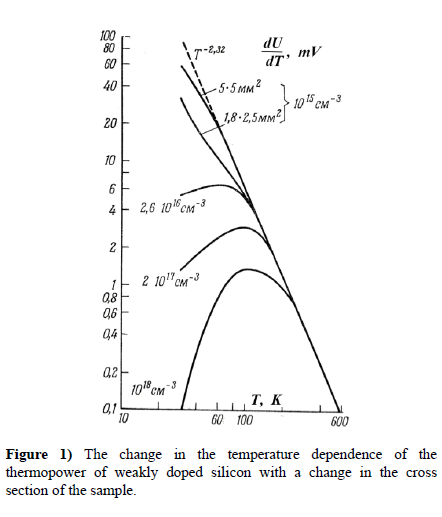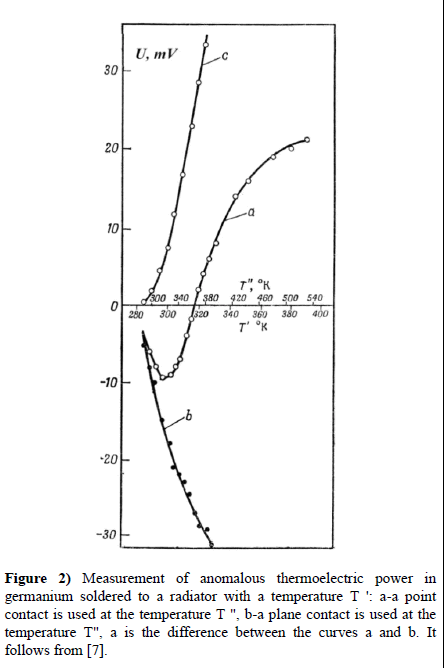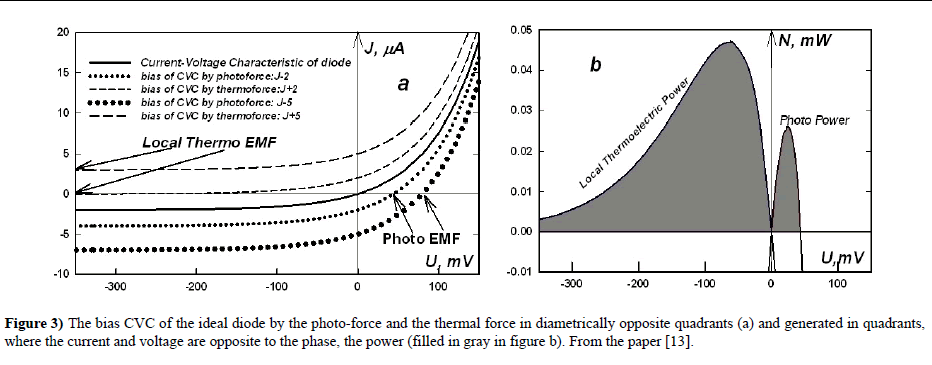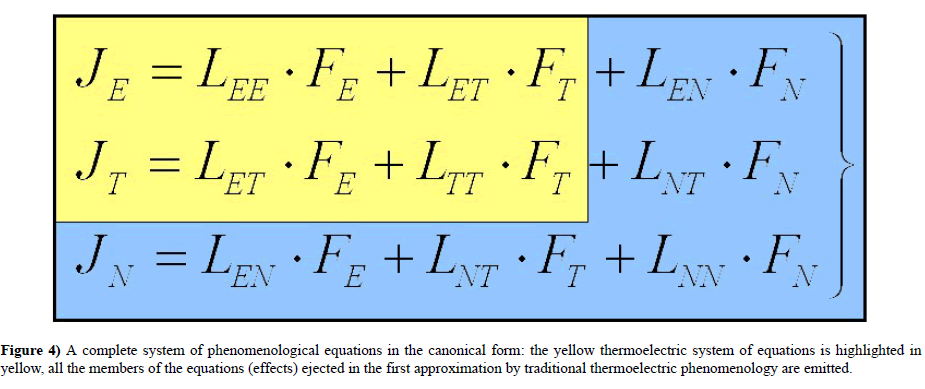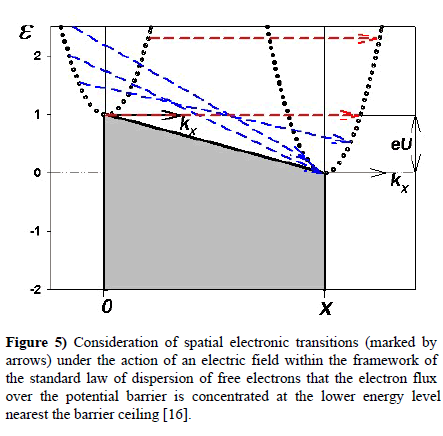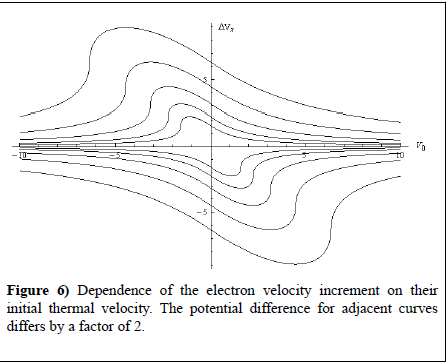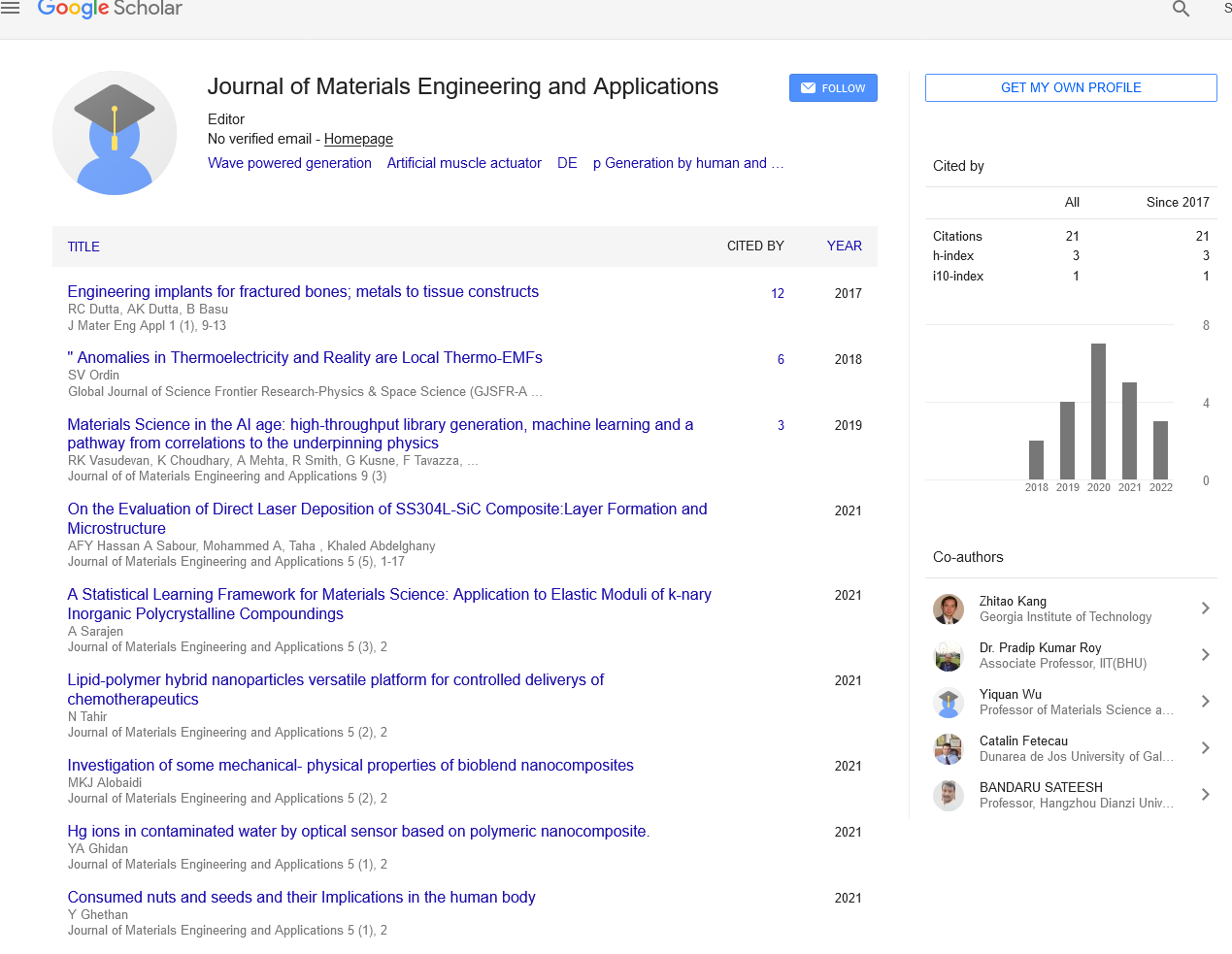"Anomalies" in thermoelectricity and reality are local thermo-EMFs
Received: 31-Jan-2018 Accepted Date: Feb 06, 2018; Published: 15-Feb-2018
Citation: Ordin SV. "Anomalies" in thermoelectricity and reality are local thermo-EMFs. J Mater Eng Appl 2018;1(1):17-20.
This open-access article is distributed under the terms of the Creative Commons Attribution Non-Commercial License (CC BY-NC) (http://creativecommons.org/licenses/by-nc/4.0/), which permits reuse, distribution and reproduction of the article, provided that the original work is properly cited and the reuse is restricted to noncommercial purposes. For commercial reuse, contact reprints@pulsus.com
Abstract
Discovered at the contacts of the giant thermoelectric power before, because their magnitude did not fit into the thermoelectric theory, and their reproducibility was low, were attributed to "anomalous." The use of contacts obtained by microelectronics technology, namely, p-n junctions and asymmetric potential barriers, made it possible to obtain high reproducibility of the effects that were identified as thermoelectric. A large series of studies carried out on silicon p-n junctions showed that the EMF arising on the optically and electrically shielded barrier in the initial section is proportional to the magnitude of the heat flux. These thermo- EMFs, commensurate in absolute value with the photo-EMF (without an optical screen at the same p-n junction) but having the opposite sign (on a constant flux) or the opposite phase (at the harmonic one) were described by injection of the main carriers of the hotter p-n junction and were called local thermo-EMF in accordance with the local production of entropy by Ilya Prigogine. The work is aimed at growing artificial structures to create highly efficient thermoelectric converters based on local thermo-EMFs.
Keywords
Thermoelectricity; Contact effects; Production of local entropyIntroduction
The history of "anomalous"-contact thermo-EMFs
The roots of thermoelectric anomalies lie in the history of thermoelectricity itself. The Seebeck effect was discovered in 1821 by T.I. Seebeck. But the question of what they measured at the contacts of the electromotive force: what they are, contact or volumetric, did not initially rise. Everything indicated that this is a three-dimensional property of the material. And they began to consider-on contact thermo-EMF of volume of a material is shown.
The Peltier effect was discovered by J. Peltier in 1834. And initially, beginning with the work of the watchmaker Peltier, who is fond of physics, this reverse thermoelectric effect, due to the fact that it is measured at contacts, was considered to be contact effects.
The Thomson effect was discovered by William Thomson in 1851 and the Benedics phenomenon (in the terminology of Tautz) were recorded as independent (additional), although they are a consequence of previously discovered Seebeck and Peltier effects, but with small concentration corrections in initially homogeneous materials. These effects were considered to be volumetric, although they were also measured at contacts.
The Thomson effect was discovered by William Thomson in 1851 and the Benedics phenomenon (in the terminology of Tautz) were recorded as independent (additional), although they are a consequence of previously discovered Seebeck and Peltier effects, but with small concentration corrections in initially homogeneous materials. These effects were considered to be volumetric, although they were also measured at contacts.
Onsager received a fundamental thermodynamic relationship [1], the principle of symmetry of the kinetic coefficients, directly indicating the volumetric character of the thermoelectric effects being investigated, in this respect, similar electrical conductivity and thermal conductivity. However, in the theory of thermoelectricity for a long time there was a confusion between the contact and volumetric thermoelectric phenomena proper. So there have been attempts to calculate the thermoelectric power from the contact potential difference [2,3].
These attempts did not bring success. And the analysis of the contact phenomena necessary for the analysis of semiconductor devices was singled out in a separate direction [4], which does not take into account the temperature gradients. And thermoelectricity was isolated in some independent direction [5], in which the difference in temperature at different contacts was considered, and not the temperature difference at the boundary of the same contact. In the pioneering work [6], Professor Anselm considered the limiting case-the separation of the boundaries of one contact by a vacuum gap, in which thermal effects cannot be neglected. This pioneering work resulted in a new thermoemission direction, where the thermoelectric effects observed at large temperature gradients were described qualitatively well by the Langmuir and Richardson models.
However, these models did not even provide a qualitative description of the spurious thermoelectric power observed sporadically at the contacts and gave negligible currents. Therefore, they were attributed to the anomalous [7]. And although the "vacuum" semiconductor model was useful for small volume thermoelectric power [8], attempts by Mahan and his followers to optimize many contact-multilayer barrier structures in these representations [9-11] did not bring much success, the base of Richardson's formula was given by negligibly small currents.
Thus, historical confusion in the definitions of thermoelectric parameters and the inability of the theory to describe contact thermoelectric effects and sent them to the category of anomalies.
Experimental observation of thermoelectric "anomalies"
The difference between the experimental results of thermoelectric power measurements and the predictions of the simplest, but traditionally used in thermoelectric production, is cautiously pointed out long ago. Thus, according to the data [12], at low temperatures, with an increase in the mean free path of electrons, a change in the thermoelectric power is observed with a change in the geometry of even homogeneous, pure samples (Figure 1) and, correspondingly, the density of heat flux through it.
But the electrical engineer, with incomplete higher education, but who knows mathematics well and personally launched the production of the first point-turn Ge-transistors at the same time as Bell (for which he was immediately awarded the title of Doctor of Technical Sciences, and later - the title of professor at the American University) Jan Tautz, not could be limited to the simplest thermoelectric models when designing their transistors. And in his classic book for photo-energetics [7], the results of his own measurements of anomalous, which depend on the method of measuring the thermoelectric power (Figure 2), are presented and various variants of their description are considered.
Figure 2: Measurement of anomalous thermoelectric power in germanium soldered to a radiator with a temperature T ': a-a point contact is used at the temperature T ", b-a plane contact is used at the temperature T", a is the difference between the curves a and b. It follows from [7].
So, the giant thermoelectric power observed later occasionally at the contacts was attributed to the anomalous yet by Tauz during the investigation of the first p-n junctions formed by him. And for correct explanation of these anomalous thermoelectric power it was necessary to return again to p-n junctions, in which Tauz found them, but which until recently were not found in strict explanation and, as a consequence, were not taken into account either in transistors or photodiodes. While the unobscured Tautz, even in the first experiments, their influence on the properties of semiconductor devices was noted and tried to give them a rigorous mathematical description.
Qualitatively, the appearance of significant temperature drops at micron potential barriers is knitted with the absorption and release of a giant energy of the order of the height of the potential energy barrier per electron. Taking into account the difference in temperature on the p-n junction plates, precision measurements showed a displacement of current-voltage characteristics, similar to their displacement in the photoelectric effect, but in a diametrically opposite quadrant (Figure 3).
Figure 3: The bias CVC of the ideal diode by the photo-force and the thermal force in diametrically opposite quadrants (a) and generated in quadrants, where the current and voltage are opposite to the phase, the power (filled in gray in figure b). From the paper [13].
Theoretical descriptions of thermoelectric "anomalies"
In fact, even Tautz, in an attempt to explain the thermoelectric "anomalies", introduced a model of barrier thermoelectricity [7], in parallel with Andrei Ivanovich Ansel'm [7], and a model of concentration thermoelectricity (using previously recorded effects of Thomson and Benedict). But neither the predecessors of Tautz, nor himself, nor numerous followers/developers of his models, did not take into account two principal points (noted and taken into account in my last works).
First, the fact that barrier effects and concentration effects are phenomenologically related and cannot be correctly described separately.
And secondly, in the framework of the traditional phenomenology of thermoelectricity, which is limited to the consideration of two equations of coupling between two thermodynamic forces and two flows: electrical and thermal, the concentration force and flux are, in the first approximation, thrown out of consideration-there is only one independent, by the Onsager symmetry principle, cross-ratio/effect Seebeck/Peltier.
And, as a consequence of these two reasons, all previously used models for describing "anomalous" thermo-EMFs, in principle, are applicable only to the description of small corrections, but not as for giant deviations in the first approximation from the traditional thermoelectric effects of Seebeck/Peltier. In order to describe giant local thermo-EMFs in the first approximation, and not as corrections (small) to diffuse thermoelectricity, the initial account of the concentration force [13] and the expansion of phenomenology [14] (Figure 4).
This theoretical "anomaly" also imposed an anomaly on giant local (in particular contact) thermo-EMFs, whose existence was actually "solved" by Ilya Prigogine, introducing the concept of local entropy production [15].
A calculation of the probability of a spatial transition showed (Figure 5), It is this "electronic condensate", which gives currents several orders of magnitude greater than the currents of Richardson and has translated "anomalies" into actually observed local thermo-EMFs. This result not only completely closed the question of the measurability of local thermo- EMFs, but also showed a higher efficiency of devices based on them than on traditional diffuse thermoelectricity, which reached its theoretical limit [13].
Figure 5: Consideration of spatial electronic transitions (marked by arrows) under the action of an electric field within the framework of the standard law of dispersion of free electrons that the electron flux over the potential barrier is concentrated at the lower energy level nearest the barrier ceiling [16].
An investigation of micro-structured materials up to nano-level has shown that without directional anisotropy of the medium, both micro- and nanostructuring gives simply a new efficient macroscopic medium [17,18] all with the same macroscopic limitations of the efficiency of thermoelectric energy conversion. While a correct separation of the bulk and thermoelectrical properties of the material itself [19,20], it was possible to construct a fundamentally new thermoelectric medium [21]. Traditional theoretical macroscopic prohibitions on the existence of a thermoelectric power in the proper contact region were removed in the works of Ilya Prigogine on the production of local entropy [15].
Longitudinal thermoelectric effect across the film.
A longitudinal thermoelectric effect along thin films has been used for a long time, in particular, for some detectors. However, the small diffuse effects of Seebeck and Peltier were rightly thrown out of consideration when constructing the elements of electronics. In addition, the skeptical attitude of specialists in the field of traditional thermoelectricity to measurements of the thermoelectric power across the film is also based on the concepts of volume kinetic coefficients, on the formal representation of an infinitesimal temperature drop on the semiconductor structure itself and, consequently, on the negligibly small integral thermal-EMF of the film. With this traditional approach, the formation of potential barriers at the film boundary is thrown out of consideration, which in itself gives other thermo-EMFs, and no less important, giant thermal effects at the film boundaries, in order of magnitude, corresponding to energies per electron of the order of height of the potential barrier (Figure 6).
However, the conducted cycle of studies of contact thermo-EMF [21-23], named according to Prigogine's representations by local thermo-EMFs, confirmed both the high-voltage character of the thermoelectric power at the micron scale and the high efficiency of energy conversion on the basis of local thermo-EMFs [24].
Moreover, even the simplest energy diagram of the film device, even without taking into account the barrier effects at the semiconductor/metal boundaries, indicates the determining contribution of contact thermo- EMFs whose model based on the contact potential difference has long been described [3]. But for a correct description of the operation of the device element on the basis of "anomalous" thermo-EMFs, it is necessary to calculate the magnitude of potential barriers both at the metalsemiconductor interface and at the boundaries within the semiconductor structure and take into account the ballistic contribution to the formation of local thermo-EMFs.
Thus, it is precisely on the thin films used across the heat flux that the contact potential difference works, whereas on thick films the large contribution of the bulk diffuse thermoelectric power is determined. On the basis of this technology, it will be possible to create a higher-voltage and more efficient energy converter than suggested [25], and possibly more efficient than real photo-detectors [26].
REFERENCES
- L. Onsager, Phys. Rev., 1931, N 37, 405, N38, 2265.
- A. F. Ioffe, Semiconducteurs e’lectroniques, Paris, 1935
- S.E. Frish and A.V. Timoreva, Course of General Physics, Volume 2, §§156,158, Theory of Contact Potential Difference, Thermoelectric Phenomena, p. 212- 224, Moscow-Leningrad, State Publishing House of Technical and Theoretical Literature., 1952.
- G. E. Pickus, Contacts phenomena, Chapter 4 in the book: Semiconductors in a science and engineering, v. I, Moscow - Leningrad., publishing house an Academy of Sciences USSR, 1957, p. 113 - 132.
- L. S. Stilbans, The thermoelectric phenomena, Chapter 6 in the book: Semiconductors in a science and engineering, v. I, Moscow - Leningrad., publishing house an Academy of Sciences USSR, 1957, p. 113 - 132.
- A.I. Ansel'm, Thermoelectronic Vacuum Thermoelement, USSR Academy of Sciences Publishing House, Moscow-Leningrad, 1951, 25p.
- Jan Tautz, "Photo - and thermoelectric phenomena in semiconductors", (translation from Czech) Moscow, Publishing House of Foreign Literature, 1962, 254 p.
- C. Herring, in b. Halbleiter und Phosphore, ed. M. Scho'n and H. Welker, Vieweg, Braunscheig, 1958, p.184.
- G. D. Mahan, J. Appl. Phys. 76, 4362 (1994)
- G. Mahan, B. Sales and J. Sharp, Physics Today, (March 1997) pp 42
- G. D. Mahan, Solid State Physics, 51, ed. H. Ehrenreich and F. Spaepen (Academic Press, 1998) pp 81
- Kroko L.J., Mines A.G., Solid State Electronics, 8, 829 (1965)
- S. V. Ordin, American Journal of Modern Physics, “Refinement and Supplement of Phenomenology of Thermoelectricity”, Volume 6, Issue 5, September 2017, Page: 96-107.
- S.V. Ordin, "Experimental and Theoretical Expansion of the Phenomenology of Thermoelectricity", Global Journal of Science Frontier Research: A - Physics & Space Science, (GJSFR-A) Volume 18, Issue 1, Version 1.0, 2018.
- Prigogine, D. Kondepudi, "MODERN THERMODYNAMICS, From Heat Engines to Dissipative Structures, John Wiley & Sons, Chichester-New York, World, Moscow, 2002, 462 pp.
- Ordin S. V., Ballistic model of the movement of electrons over potential hill, PHTI of A. F. Ioffe of the Russian Academy of Sciences, St.-Petersburg, Russia, Interstate Conference: Thermoelectrics and their application, on November, 2014, Proceedings, St.-Petersburg, Russia, 2015, p. 199-203, http://www.rusnor.org/pubs/articles/11583.htm, 14.11.2014, 10 pp.
- Y. Okamoto, S.V. Ordin, T. Miyakawa, IR-characterization of sintering SiC thermoelectric semiconductors with use of 4-component effective medium model, Journal of Applied Physics,v.85,9, 1998, p. 6728-6737.
- S.V. Ordin, "Peltier Heat as a Volume Property and Optimization of Working Regimes of Thermoelements in Real Conditions", Abstracts of the XVI Int. Conf. on Thermoelectrics (ICT'97), Drezden, August,1997.
- S.V. Ordin, "Optimization of operating conditions of thermocouples allowing for nonlinearity of temperature distribution", J. Semiconductors, 31(10), p.1091-1093, 1997.
- S.V. Ordin, A.J. Zjuzin, I.A. Sokolov, "Thermoelectric processes in p-n junctions", Phys.-Techn. Institute of A.F. Ioffe of the Russian Academy of Sciences, St.-Petersburg, Russia Works of X interstate seminar: Thermoelectrics and their application, on November, 14-15th 2006, Proceedings, p. 41-47.
- S.V. Ordin, W.N. Wang, "Thermoelectric Effects on Micro and Nano Level.", J. Advances in Energy Research, Volume 9, 2012, p. 311-342.
- S. V. Ordin, Yu. V. Zhilyaev, V. V. Zelenin, V. N. Panteleev, "Local Thermoelectric Effects in Wide-Gap Semiconductors", Semiconductors, 2017, Vol. 51, No. 7, pp. 883–886.
- Stanislav Ordin, Book: “Refinement of basic physical models”, Lambert, 2017, 82 pp. Project № 163273, ISBN: 978-3-659-86149-9.
- Ordin S.V., "Cardinal increase in the efficiency of energy conversion based on local thermoelectric effects", International Journal of Advanced Research in Physical Science, Volume-4 Issue-12, p. 5-9, 2017.
- Liping Liu, “Feasibility of large-scale power plants based on thermoelectric effects”, New J. Phys. 16 (2014) 123019, 12 pp.
- Hitoshi Sai, et al. "Triple-junction thin-film silicon solar cell fabricated on periodically textured substrate with a stabilized efficiency of 13.6%." Applied Physics Letters. DOI: 10.1063/1.4921794




